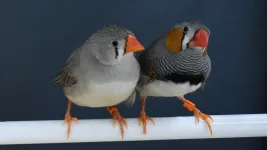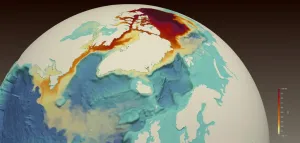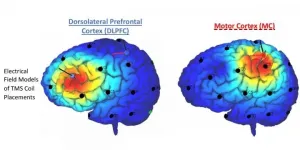Zebra finches choose nest materials based on past experience, new research shows
U of A scientists find that learning and past success play a role in how birds build their nests
2021-02-25
(Press-News.org) When building a nest, previous experience raising chicks will influence the choices birds make, according to a new study by University of Alberta scientists.
The results show that birds that have successfully raised families stick with tried-and-true methods when building their nests, whereas less successful birds will try something new.
"We found that when presented with a choice between a familiar material, coconut fibre, and a never-before-encountered material, white string, zebra finches who had successfully raised chicks preferred to stick with the same material they had previously used. Birds who failed to raise chicks built nests with equal amounts of familiar and novel material," explained Andrés Camacho-Alpízar, a PhD student in the Faculty of Science.
Male Zebra Finch selecting string
The research shows that nest building is a behaviour based on learning and past experiences, and sheds new light on the decision-making processes birds use when creating nests.
"Much like human architecture is ever-adapting--from changing styles to improved construction materials--birds also adapt their nest-building behaviour based on trial-and-error learning," added Camacho-Alpízar, who conducted the study under the supervision of Lauren Guillette, assistant professor in the Department of Psychology.
The study also showed that all birds took fewer days to complete their second nests compared with their first nest.
Zebra Finch nests
Nests built by previously successful (left) and unsuccessful (right) zebra finches. The nest on the left is built mainly with coconut fibre, a familiar material type for the birds. The nest on the right was built with a more equal proportion of familiar and new material, in this case white string. (Photo: Animal Cognition Research Group)
"This study adds to the small but growing area of research about nest-building behaviour that challenges long-held assumptions about why animals do what they do," said Guillette.
"While one can find many references in both the scientific and lay literature that suggest nest building in birds is entirely pre-programmed, our work shows that birds learn and modify the material they put into their nest based on past breeding experiences with that or similar material."
INFORMATION:
This research was funded by the Natural Sciences and Engineering Council of Canada.
The study, "If it ain't broke don't fix it: breeding success affects nest-building decisions," was published in Behavioural Processes.
[Attachments] See images for this press release:

ELSE PRESS RELEASES FROM THIS DATE:
2021-02-25
America's stark racial disparities in health care have been exposed by COVID-19, but a new study from Michigan State University suggests that Black individuals are more likely than conservative White people to adhere to public health standards due to disparities.
The study, published in the Journal of Racial and Ethnic Health Disparities, used data from MSU's State of the State Survey that was captured during the initial COVID-19 outbreak from a representative group of 800 adults in Michigan.
"Our findings suggest that although COVID impacts all Michiganders, ...
2021-02-25
Fiber-optic cables run underneath nearly all city grids across the United States and provide internet and cable TV to millions, but what if those systems could also provide valuable information related to hazardous events such as earthquakes and flooding? A team of researchers at Penn State have found they can do just that.
The scientists are using fiber-optic distributed acoustic sensing (DAS) technology to turn existing telecommunication infrastructure that is already installed underground into a valuable resource for monitoring ground vibrations.
"We discovered the fibers could pick up a wide variety of signal vibrations, from thunderstorms to human walking steps to music concerts," said Tieyuan Zhu, assistant professor of geophysics at Penn State and principal investigator on ...
2021-02-25
American Geophysical Union U.S. Geological Survey Joint ReleaseWASHINGTON--Southern California can now expect to see post-wildfire landslides occurring almost every year, with major events expected roughly every ten years, a new study finds. The results show Californians are now facing a double whammy of increased wildfire and landslide risk caused by climate change-induced shifts in the state's wet and dry seasons, according to researchers who mapped landslide vulnerability in the southern half of the state.
"This is our attempt to get people thinking about where these hazards are going to be before there's even a fire," said Jason Kean, a hydrologist at the U.S. Geological Survey in Denver and lead author ...
2021-02-25
HOUSTON - (Feb. 25, 2021) - A new theory by Rice University scientists could boost the growing field of spintronics, devices that depend on the state of an electron as much as the brute electrical force required to push it.
Materials theorist Boris Yakobson and graduate student Sunny Gupta at Rice's Brown School of Engineering describe the mechanism behind Rashba splitting, an effect seen in crystal compounds that can influence their electrons' "up" or "down" spin states, analogous to "on" or "off" in common transistors.
"Spin" is a misnomer, since quantum physics constrains electrons ...
2021-02-25
BUFFALO, N.Y. -- Graphene is incredibly strong, lightweight, conductive ... the list of its superlative properties goes on.
It is not, however, magnetic -- a shortcoming that has stunted its usefulness in spintronics, an emerging field that scientists say could eventually rewrite the rules of electronics, leading to more powerful semiconductors, computers and other devices.
Now, an international research team led by the University at Buffalo is reporting an advancement that could help overcome this obstacle.
In a study published today in the journal Physical Review Letters, researchers describe how they paired a magnet with graphene, and induced what they describe as "artificial magnetic texture" in the nonmagnetic wonder material.
"Independent of each ...
2021-02-25
As climate change increases the occurrence of catastrophic natural disasters around the world, international organizations are looking for ways to reduce the risk of such disasters. One approach under exploration is the humanitarian community's forecast-based early action (FbA), which seeks to enable pre-emptive actions based on forecasts of extreme events.
With FbA, disaster response shifts toward anticipating disasters to ameliorate their destructive effects. However, the development of data-based triggers and metrics for action rely on timely and accurate information. A group of researchers publishing in SPIE's END ...
2021-02-25
HOUSTON - (Feb. 25, 2021) - COVID-19 can be diagnosed in 55 minutes or less with the help of programmed magnetic nanobeads and a diagnostic tool that plugs into an off-the-shelf cell phone, according to Rice University engineers.
The Rice lab of mechanical engineer Peter Lillehoj has developed a stamp-sized microfluidic chip that measures the concentration of SARS-CoV-2 nucleocapsid (N) protein in blood serum from a standard finger prick. The nanobeads bind to SARS-CoV-2 N protein, a biomarker for COVID-19, in the chip and transport it to an electrochemical sensor that detects minute amounts of the biomarker.
The ...
2021-02-25
LOS ALAMOS, N.M., February 24, 2021--The Beaufort Sea, the Arctic Ocean's largest freshwater reservoir, has increased its freshwater content by 40 percent over the last two decades, putting global climate patterns at risk. A rapid release of this freshwater into the Atlantic Ocean could wreak havoc on the delicate climate balance that dictates global climate.
"A freshwater release of this size into the subpolar North Atlantic could impact a critical circulation pattern, called the Atlantic Meridional Overturning Circulation, which has a significant influence on northern-hemisphere climate," ...
2021-02-25
After traveling several billion miles toward the Sun, a wayward young comet-like object orbiting among the giant planets has found a temporary parking place along the way. The object has settled near a family of captured ancient asteroids, called Trojans, that are orbiting the Sun alongside Jupiter. This is the first time a comet-like object has been spotted near the Trojan population.
The unexpected visitor belongs to a class of icy bodies found in space between Jupiter and Neptune. Called "Centaurs," they become active for the first time when heated as they approach the Sun, and dynamically transition into becoming more comet-like.
Visible-light snapshots by NASA's Hubble Space Telescope reveal that the vagabond object shows signs of comet activity, such as a tail, ...
2021-02-25
Researchers have discovered that there may be a new pathway in the brain that provides pain relief and reduces cravings for opioids.
Over a third of the U.S. population suffers from chronic pain, with little to no reported relief from medication. Transcranial magnetic brain stimulation (TMS) is a noninvasive form of brain stimulation that may offer a new treatment option for these underserved members of our community.
In a recent paper in Drug and Alcohol Dependence, researchers at the Medical University of South Carolina evaluated two different strategies for relieving pain with TMS: applying TMS to the motor cortex and the ...
LAST 30 PRESS RELEASES:
[Press-News.org] Zebra finches choose nest materials based on past experience, new research shows
U of A scientists find that learning and past success play a role in how birds build their nests








